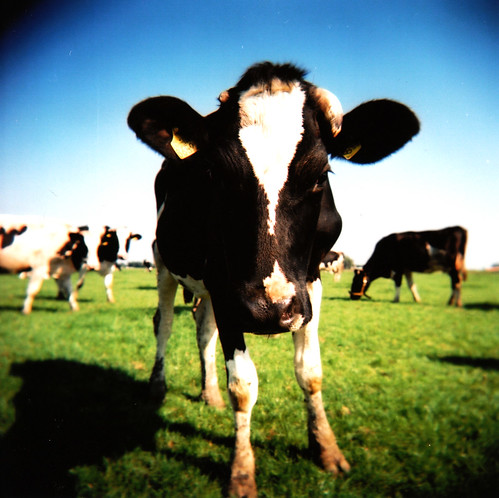November 2012
 |
| Photo of non-gm cow by JelleS on Flickr |
The U.S. media has made much of the
latest “impressive (GM) technical feat that won plaudits in the
biotechnology world”. This impressive feat is the creation by
scientists in New Zealand of a GM cow called Daisy.
Daisy's milk is missing
'β-lactoglobulin',
a “key” protein often responsible for triggering allergies. In
the first year of life, as many as two or three in every hundred
infants are allergic to this protein.
Rather than report the huge ethical,
scientific and safety issues surrounding the novel cow, journalists
have chosen instead to lament the “hopeless logjam” caused by the
U.S. government in its failure to rush GM animal products to market.
Also due to the regulatory incompetence which, it seems, is having “a
chilling effect on animal biotech efforts”, GM animal research is
being abandoned or transferred overseas. One Canadian scientist is
quoted as saying his GM pigs have had to be banked in cold storage
until “societal attitudes improve”.
Before blaming the government and
public for the lack of GM super-animals in the world, perhaps the
journalists should have considered the matter in more depth.
Genetically modification of animals
poses overwhelming ethical questions.
The suffering of the surrogate dams
which bear the GM offspring, and of the mutant offspring themselves
are unacceptable. Both suffer physical trauma, health problems and,
more often than not, death. For example, to produce one cow with
altered milk, 57 attempts gave rise to only five successful
transformations, four successful pregnancies, and a single live
female calf which had to be delivered a month prematurely by
caesarian section due to hydroallantois (water accumulation caused by
a defective placenta). At only 7 months of age, Daisy was treated
with hormones to induce lactation. The technique is cruel.
Safety considerations surround the
unpredictable nature of all genetic transformations, and even more so
the biotech technique used in the making of this GM cow. The
engineered DNA inserted is not a gene, but produces small molecules
of a similar coding molecule, micro-RNA. This micro-RNA is a gene
regulator and its action switches off the cow's problem-protein gene
off.
Data on micro-RNA molecules are the
latest thing to roll off the genome-analysts' benches. The DNA which
produces them is thought to comprise as much as 20% of the genome,
while the actual protein-coding genes amount to only some 2%.
These controlling elements are not only
more abundant than genes, but they exist in more variant forms, they
interact with each other, and a single micro-RNA may have a
multiplicity of actions. In the bigger picture, the parts of the
genome influenced by a micro-RNA may not lie anywhere near it, and
micro-RNA action is thought to extend to communication between cells.
The whole micro-RNA scene has been described as “stunningly
complex”, “almost incomprehensible” and “almost inconceivably
intricate”. One scientists said graphically “My head explodes at
the amount of data”.
Given the nature of micro-RNA described
above super-imposed on the wealth of dodgy manipulations needed in
cloning, is it reasonable to expect that we can control the
outcome? Well consider this: the “impressive technical feat”
called Daisy was born without a tail.
What can (or should have been)
predicted in the quest to eliminate this major protein from cow's
milk, is that the cow's body knows it needs that protein. If it
can't make β-lactoglobulin,
it makes more of other proteins to compensate. In this case, one of
the 'other' proteins in the GM milk turns out to be casein, which is
another well-known allergy-trigger. One US pediatrician said that
usually children are allergic to a variety of milk proteins,
including casein, so taking out one
of them won't help. In fact, the higher casein therefore
presents “probably the worst-case scenario for most of our
patients”.
One of the biggest unknowns is the
effects that artificial micro-RNA might have inside our bodies.
These regulatory molecules are small, and can survive digestion: they
have been found circulating in the blood-stream from where they can
reach any organ. Their action is not species-specific: they have
been shown to be able to interfere with the function of liver cells
(see BEWARE NON-GENETIC ENGINEERING - November 2011)
OUR COMMENT
In light of all of the above, is the
problem with GM animals really
regulatory bumbling or societal attitudes?
Hypo-allergic milk is clearly intended
to be targeted at the young. How many parents, knowing all the
above concerns would feed it to their children?
Moreover, even the
underlying concept of eliminating one “key” protein from milk is
clearly faulty.
The protein compensation
seen in the GM cow when an attempt was made to artificially change
the levels of a single protein may well be present in some form in
all GM animals and plants. In other words, the generation of
'novel' proteins by a GM organisms might extend very far beyond the
man-made one, with no guarantee of safety.
At the moment, GM animal produce are
nowhere near the horizon, but keep an eye out for them.
SOURCES
- Rosie Mestel, Scientists fret over FDA slowness on genetically altered animals, Los Angeles Times, 1.10.12
- GM Calf Research Ignores Ethical Problems, Raises Safety Concerns, GM Freeze News Release, 3.10.12
- Lin Zhang et al., 2011, Exogenous plant MIR168a specifically targets mammalian LDLRAP1: evidence of cross-kingdom regulation by microRNA, Cell Research
- Breakthrough study overturns theory of 'junk DNA' in genome, Guardian, 5.09.12
- Gina Kolata, Bits of Mystery DNA, Far From 'Junk,' Play Crucial Role, New York Times, 5.09.12
- Ian
Sample, GM cow designed to produce milk without an
allergy-causing protein,
Guardian, 1.10.12
No comments:
Post a Comment
Thanks for your comment. All comments are moderated before they are published.